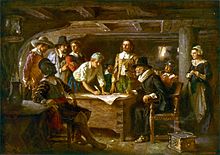
The Mayflower Compact was an iconic document in the history of America, written and signed aboard the Mayflower on November 11, 1620, while anchored in Provincetown Harbor in Massachusetts. The Compact was originally drafted as an instrument to maintain unity and discipline in Plymouth Colony, but it has become one of the most historic documents in American history. It was published in London in Mourt's Relation in 1622, and the authors had added a preamble to clarify its meaning: "it was thought good there should be an association and agreement, that we should combine together in one body, and to submit to such government and governors as we should by common consent agree to make and choose."
Forty-one men signed the Compact, beginning with Governor John Carver and ending with Edward Lester. Nine adult males on board did not sign the document; some had been hired as seamen only for one year and others may have been too ill to write. No women signed it, in accordance with cultural and legal custom of the times.[1][2]
What is known today of the wording of the Mayflower Compact comes from William Bradford’s manuscript, apparently copied from the original document. The original of the Mayflower Compact has long been lost, possibly stolen during the American Revolutionary War (1775-1783). The text was first published in 1622 and then in Bradford's journal from about 1630. Plymouth Colony secretary Nathaniel Morton provides both text of the Compact and a list of signers in his 1669 New Englands Memoriall, and it is possible that this list was in the sequence of their signing.
The list of signers was published at least twice in the 18th century, but each time based apparently on Morton's 1669 list and not the original. Consequently, there has been confusion for many years about the actual list of signers. Some suggest there would be names besides those Morton had provided if all adult male passengers had signed the compact. Morton apparently copied from Bradford, and not from the original written and signed compact.
The Morton signer list from 1669 is what most Mayflower scholars have used when compiling a list of those who signed. That list is used in the Stratton book on page 413 and is what is used here. There are variations in the spelling of some names between Stratton's list and Morton's 1669 list, and those 13 instances are also noted here.[3][4]
- ^ Nathaniel Philbrick, Mayflower: A story of Courage, Community and War (New York:Viking, 2006), p. 43
- ^ Nick Bunker, Making Haste from Babylon: The Mayflower Pilgrims and their New World a History (New York: Knopf 2010), p. 281
- ^ Eugene Aubrey Stratton, Plymouth Colony: Its History and People, 1620-1691 (Salt Lake City:Ancestry Publishing 1986) pp. 411-413
- ^ Caleb Johnson, Mayflower Compact